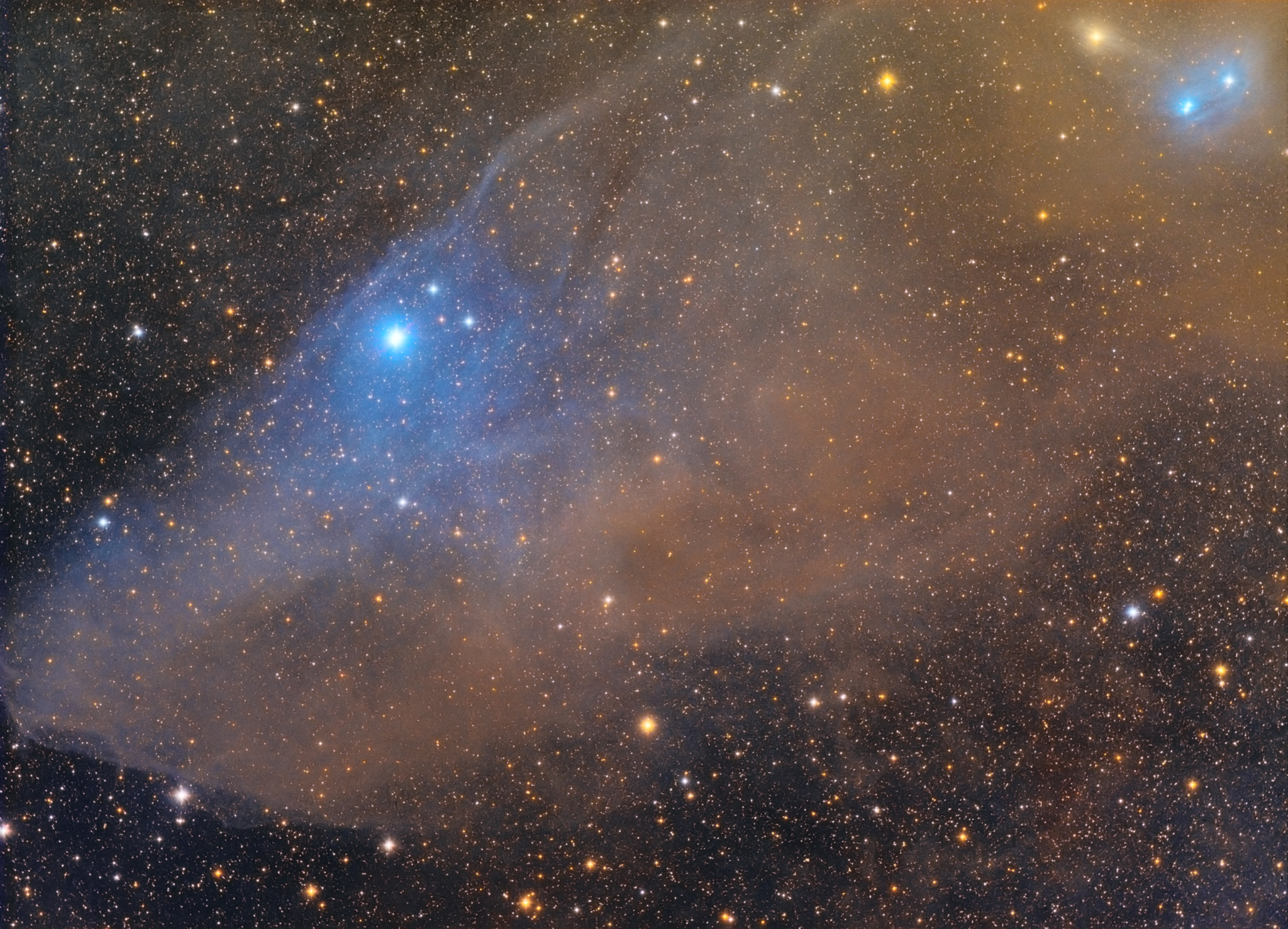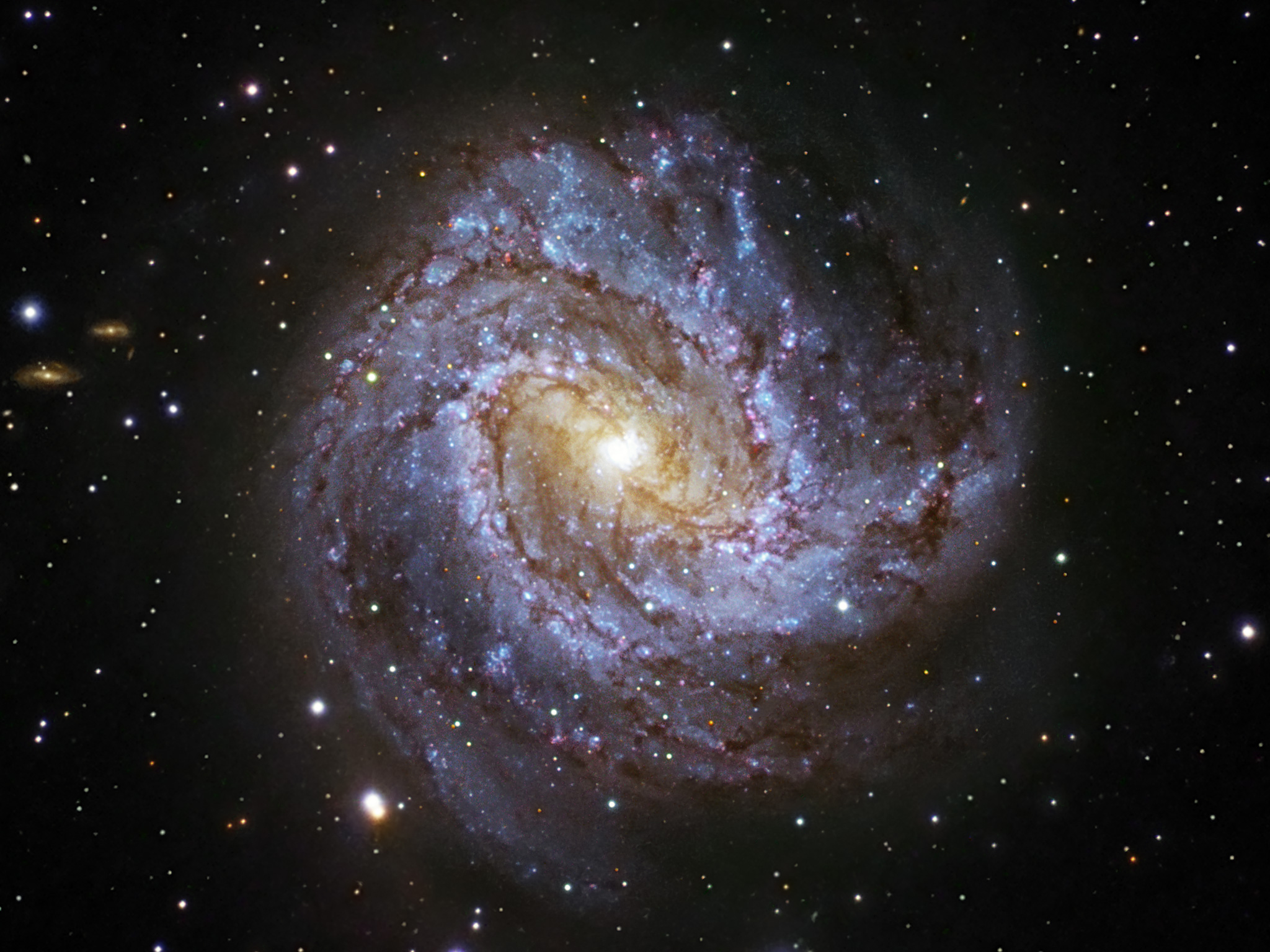Blog
This intriguing new view of a spectacular stellar nursery IC 2944 is being released to celebrate a milestone: 15 years of ESO’s Very Large Telescope. This image also shows a group of thick clouds of dust known as the Thackeray globules silhouetted against the pale pink glowing gas of the nebula. These globules are under fierce bombardment from the ultraviolet radiation from nearby hot young stars. They are both being eroded away and also fragmenting, rather like lumps of butter dropped onto a hot frying pan. It is likely that Thackeray’s globules will be destroyed before they can collapse and form new stars.

Ike Sturm (born 29 June 1978 in Wisconsin) is a bassist, composer, and bandleader in New York. He serves as Music Director for the Jazz Ministry at Saint Peter’s Church in Manhattan.
Raised in a musical home in Wisconsin, Sturm learned from his father, composer and arranger Fred Sturm. He received degrees from the Eastman School of Music and has performed with Gene Bertoncini, Donny McCaslin, Bobby McFerrin, Ben Monder, Ingrid Jensen, Steve Lehman, Maria Schneider, Kenny Wheeler and many others. He has played on four Down Beat award-winning recordings as well as Steve Reich‘s albums for Cantaloupe Music and Nonesuch Records. He has appeared with the International Contemporary Ensemble, Signal and Alarm Will Sound.
Commissioned by Saint Peter’s Church, he composed Jazz Mass as a large-scale work featuring choir, string orchestra, and saxophonist Donny McCaslin. The recording received 4 1/2 stars rating and was named among the Best of 2010 in Down Beat magazine. Jazz Mass premiered in Europe in 2011 at the Gedächtniskirche in Berlin.
more...Eva Narcissus Boyd (June 29, 1943 – April 10, 2003), known by the stage name of Little Eva, was an American pop singer. Although some sources claim that her stage name was inspired by a character from the novel Uncle Tom’s Cabin, she stated in an interview that she was named after her aunt, which prompted her family to call her “Little Eva.”
Boyd was born in Belhaven, North Carolina in 1943 and had twelve siblings. At the age of fifteen she moved to the Brighton Beach section of Brooklyn, New York. As a teenager, she worked as a maid and earned extra money as a babysitter for songwriters Carole King and Gerry Goffin.
It is often claimed that Goffin and King were amused by Boyd’s particular dancing style, so they wrote “The Loco-Motion” for her and had her record it as a demo (the record was intended for Dee Dee Sharp). However, as King said in an interview with NPR and in her “One to One” concert video, they knew she could sing when they met her, and it would be just a matter of time before they would have her record songs they wrote, the most successful being “The Loco-Motion.” Music producer Don Kirshner of Dimension Records was impressed by the song and Boyd’s voice and had it released.The song reached No. 1 in the United States in 1962. It sold over one million copies, and was awarded a gold disc. After the success of “The Loco-Motion,” Boyd was stereotyped as a dance-craze singer and was given limited material.
The same year, Goffin and King wrote “He Hit Me (And It Felt Like A Kiss)” (performed by the Crystals) after discovering that Boyd was being regularly beaten by her boyfriend. When they inquired why she tolerated such treatment, Eva replied without batting an eyelid that her boyfriend’s actions were motivated by his love for her.
more...Julian Priester (born June 29, 1935) is an American jazz trombonist. He is sometimes credited “Julian Priester Pepo Mtoto”. He has played with Sun Ra, Max Roach, Duke Ellington, John Coltrane, and Herbie Hancock.
Priester attended Chicago’s DuSable High School, where he studied under Walter Dyett. In his teens he played with blues and R&B artists such as Muddy Waters, and Bo Diddley, and had the opportunity to jam with jazz players like saxophonist Sonny Stitt.
In the early 1950s, Priester was a member of Sun Ra‘s big band, recording several albums with the group before leaving Chicago in 1956 to tour with Lionel Hampton and he joined Dinah Washington in 1958. The following year he settled in New York and joined the group led by drummer Max Roachwho heard him playing on the Philly Joe Jones album, “Blues for Dracula” (1958). While playing in Roach’s group, Priester also recorded two albums as a leader, Keep Swingin’ and Spiritsville, both of which were recorded and released by Riverside (the latter by their Jazzland subsidiary) in 1960.
Priester recorded two albums with trumpeter Booker Little in 1961, Out Front and Booker Little and Friend (also known as Victory and Sorrow), the first also features Roach, and Priester took part in the sessions for John Coltrane‘s Africa/Brass album, which was recorded in the same year. He left Roach’s band during 1961, and between then and 1969 appeared as a sideman on albums led by Freddie Hubbard, Stanley Turrentine, Blue Mitchell, Art Blakey, Joe Henderson, McCoy Tyner, Johnny Griffin, and Sam Rivers. In 1969, he accepted an offer to play with Duke Ellington‘s big band, and he stayed with that ensemble for six months before leaving in 1970 to join pianist Herbie Hancock‘s fusion sextet.
more...Ralph Jose P. Burns (June 29, 1922 – November 21, 2001) was an American jazz pianist, composer, and arranger.
Burns was born in Newton, Massachusetts, United States, where he began playing the piano as a child. In 1938, he attended the New England Conservatory of Music. He admitted that he learned the most about jazz by transcribing the works of Count Basie, Benny Goodman and Duke Ellington. While a student, Burns lived in Frances Wayne‘s home. Wayne was already a well-known big band singer and her brother Nick Jerret was a bandleader who began working with Burns. He found himself in the company of such famous performers as Nat King Cole and Art Tatum.
After Burns moved to New York in the early 1940s, he met Charlie Barnet and the two began working together. In 1944, he joined the Woody Herman band with members Neal Hefti, Bill Harris, Flip Phillips, Chubby Jackson and Dave Tough. Together, the group developed a powerful and distinctive sound. For 15 years, Burns wrote or arranged many of the band’s major hits including “Bijou”, “Northwest Passage” and “Apple Honey”, and on the longer work “Lady McGowan’s Dream” and the three-part Summer Sequence. Burns worked with numerous other musicians. Stan Getz was featured as a tenor saxophone soloist on “Early Autumn“, a hit for the band and the launching platform for Getz’s solo career. Burns also worked in a small band with soloists including Bill Harris and Charlie Ventura.
more...The Blue Horsehead Nebula (IC 4592) is a faint reflection nebula of about 40 light-years across, located some 420 light-years away from Earth in the southern constellation of Scorpius, near the center of our Milky Way Galaxy.
The characteristic blue hue of reflection nebulae is caused by the tendency of the fine dust within these nebulae to more strongly scatter blue starlight. In this case, the nebula is lit by a very bright star on the nasal bridge of the horse.
That star – called Nu Scorpii and also known as Jabbah, the Arabic name for “the forehead of the scorpion” – appears to be a single star, but is actually a whole system of stars (possibly as many as seven), each of which is many times more massive, larger, hotter and more luminous than our Sun.
A second, bright reflection nebula (IC 4601) is illuminated by the intense radiation of two stars near the horse’s ear (these stars of which the brightest star is known as HD 147010, and the binary star system as HD 147013, are all blue giants). The dust of IC 4601 contains the heavy elements that planets are made of, and plays a major role in the creation of new stars. There probably are baby stars wrapped in these blankets of dust.

Steve Williamson (born 28 June 1964) is an English saxophonist and composer.(tenor saxophone, soprano saxophone, alto saxophone, keyboardand composition). He has been called “one of the most distinctive saxophone voices in contemporary British jazz”.
Born in west London to Jamaican parents, Steve Williamson began playing saxophone at the age of 16 and started his career playing in reggaebands, including Misty in Roots.
In 1984 and 1985 he studied at London’s Guildhall School of Music, where he was tutored by Lionel Grigson. Williamson was a member of the noted collective of British-born black jazz musicians who came together as the Jazz Warriors in the mid-1980s.
At the Nelson Mandela 70th birthday open-air festival in 1988 Williamson played alongside Courtney Pine in Wembley Stadium and afterwards was a constant presence at Ronnie Scott’s Jazz Club. He was member of Louis Moholo‘s Viva La Black (1988) and of Chris McGregor‘s Brotherhood of Breath (1990). During the 1990s he led his own band and appeared in projects of Iain Ballamy, Maceo Parker, Bheki Mseleku, US3, and Graham Haynes.
In 1990 Williamson released his first album A Waltz for Grace with Verve, featuring vocalist Abbey Lincoln. In 1992 he released his second album, Rhyme Time, followed by Journey to Truth in 1994, featuring Cassandra Wilson.
more...Anthony John Medeski (born June 28, 1965) is an American jazz keyboard player and composer. Medeski is a veteran of New York’s 1990s avant-garde jazz scene and is known popularly as a member of Medeski Martin & Wood. He plays the acoustic piano and an eclectic array of keyboards, including the Hammond B3 organ, melodica, mellotron, clavinet, ARP String Ensemble, Wurlitzer electric piano, Moog Voyager Synthesizer, Wurlitzer 7300 Combo Organ, Vox Continental Baroque organ, and Yamaha CS-1 Synthesizer (a “kids’ toy”), among others. When playing acoustic piano, Medeski usually plays the Steinway piano and is listed as a Steinway Artist.
Medeski was born in Louisville, Kentucky, and grew up in Florida. After studying piano as a child (starting when he was five years old), he began as a teenager to perform with musicians such as Mark Murphy and Jaco Pastorius. He attended Pine Crest School. In 1983, after graduating from high school, he began studying piano at the New England Conservatory in Boston, where he performed as a sideman with Dewey Redman, Billy Higgins, Bob Mintzer, Alan Dawson. Medeski attributes his early interest in playing improvised music and jazz to listening to Oscar Peterson.
Medeski performs in a range of musical styles, from accessible groove based funk and jazz (such as the MMW albums and A Go Go with John Scofield) to more experimental music (including many of John Zorn‘s projects: Duras: Duchamp, Interzone, Liber Novus, Nova Express, Dreamachines, Templars: In Sacred Blood, At the Gates of Paradise etc. and collaborations with David Fiuczynski).
Medeski is best known for his work with Medeski Martin & Wood including drummer and percussionist Billy Martin and bassist Chris Wood. The trio formed in New York in 1991 playing gigs at The Village Gate. Since the mid-1990s they have toured steadily in both national and international funk, jazz, and jam music scenes. The band has collaborated with such musicians as Iggy Pop, Trey Anastasio and John Scofield.
more...David “Honeyboy” Edwards (June 28, 1915 – August 29, 2011) was a Delta blues guitarist and singer from Mississippi.
Edwards was born in Shaw, Mississippi. At the age of 14, he left home to travel with the bluesman Big Joe Williams, beginning life as an itinerant musician, which he maintained through the 1930s and 1940s. He performed with the famed blues musician Robert Johnson, with whom he developed a close friendship. Edwards was present on the night Johnson drank the poisoned whiskey that killed him, and his story has become the definitive version of Johnson’s demise. Edwards also knew and played with other leading bluesmen in the Mississippi Delta, including Charley Patton, Tommy Johnson, and Johnny Shines.
more...Located about 15 million light-years away towards the Hydra (the sea serpent) constellation, Messier 83 is a nearby face-on barred spiral with a classic grand design form. It is the main member of a small galactic group including NGC 5253 and about 9 dwarf galaxies. Messier 83 stretches over 40,000 light-years, making it roughly 2.5 times smaller than our own Milky Way. However, in some respects, Messier 83 is quite similar to our own galaxy. Both the Milky Way and Messier 83 possess a bar across their galactic nucleus, the dense spherical conglomeration of stars seen at the centre of the galaxies.
Messier 83 has been a prolific producer of supernovae, with six observed in the past century. This is indicative of an exceptionally high rate of star formation coinciding with its classification as a starburst galaxy. Despite its symmetric appearance, the central 1,000 light-years of the galaxy shows an unusually high level of complexity, containing both a double nucleus and a double circumnuclear starburst ring. The nature of the double nucleus is uncertain but the off centre nucleus could be a remnant core of a small galaxy that merged with Messier 83 in the past. The star clusters in the nuclear starburst rings are mostly young stars between 5 and 10 million years old. This image is based on data acquired with the 1.5-metre Danish telescope at ESO’s La Silla Observatory in Chile, through three filters (B, V, R).

Khadja Nin (born 27 June 1959) is a Burundian singer and musician.
Nin was born in Burundi, the youngest of a family of eight. Her father was a diplomat. She studied music at an early age like most of her brothers and sisters. With her exceptional singing voice, at the age of seven she became one of the lead vocalists in the Bujumbura choir and performed in the local cathedral. She left Burundi for Zaire in 1975 and married in 1978. In 1980 she emigrated to Belgium with her two-year-old son. In 1985 she obtained a contract with BMG. Her second album, a 1994 release entitled Ya Pili, was critically acclaimed.
Her breakthrough came in 1996 with her widely popular album Sambolera, which was sung in Swahili, Kirundi, and French. In 1997 she performed the song “Sailing” in a duet with Montserrat Caballé on the album Friends For Life. She successfully used a blend between African rhythms and modern pop to create her own unique brand of music. One of her most popular songs is Sina Mali, Sina Deni, a translated cover version of Stevie Wonder‘s song Free.
The first album was released in 1992, sung in Swahili. But it is best known in France in 1995 with the tube Sambolera mali sound, a title of the second album, Ya Pili (The second). The third album is a compilation of old and new titles. Jeanne Moreau makes the clip illustrating her song Mama, where she talks about her mother, on her fourth album Ya … . The texts of this album are in Swahili or Kirundi (for the chorus of the title Mama). The album also includes a cover of a piece by Gabonese musician Pierre Akendengué, Africa Obota, and a title of Stevie Wonder, Free that she renamed Sina mali, sina deni (I am neither rich nor indebted). Another piece pays tribute to Nelson Mandela, and a song calls for easing the embargo imposed on Burundi.
In January 2000, she sang at AccorHotels Arena (at the time Palais Omnisports de Paris-Bercy) with Sting and Cheb Mami. She remarries in 2006 with the Belgian car driver Jacky Ickx, and they settle in Monaco. In this marriage, she has had a son who now lives in Belgium.
In 2018, she was a jury member at the Cannes Film Festival, under the presidency of Cate Blanchett, alongside actresses Léa Seydoux and Kristen Stewart, director Ava DuVernay, actor Chang Chen and directors Robert Guédiguian, Denis Villeneuve and Andrey Zvyagintsev.
more...More Posts
- Kevin Locke Memorial
- Daily Roots The Heptones
- Cosmos Arp-Madore 608-333
- Steve Reich
- Chubby Checker
- Stevie Ray Vaughan
- Von Freeman
- SAVE UKRAINE World Music Trio Mandili
- Daily Roots Cornel Campbell
- Cosmos Pulsar J0002-6216
- Wahed Wafa
- Sting
- Prasanna Ramaswamy
- Howard Roberts
- World Music Adédèjì
- Daily Roots KC White
- Cosmos M42
- Ellen Mcllwaine
- Donny Hathaway
- Dave Holland